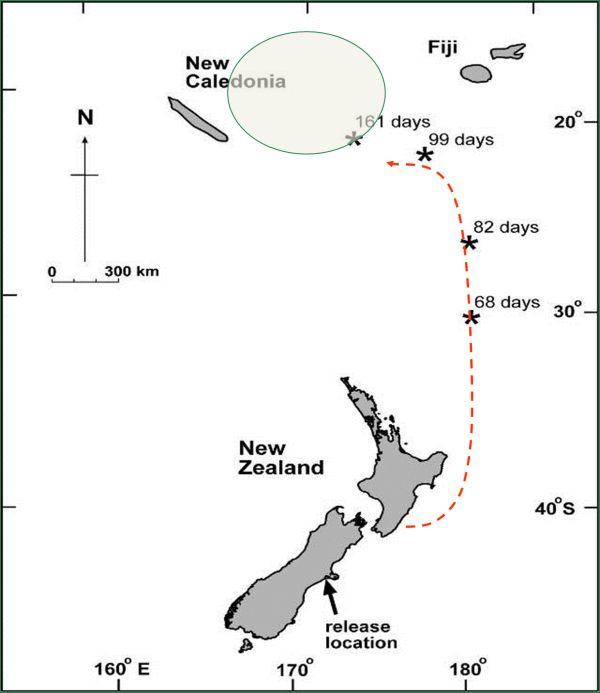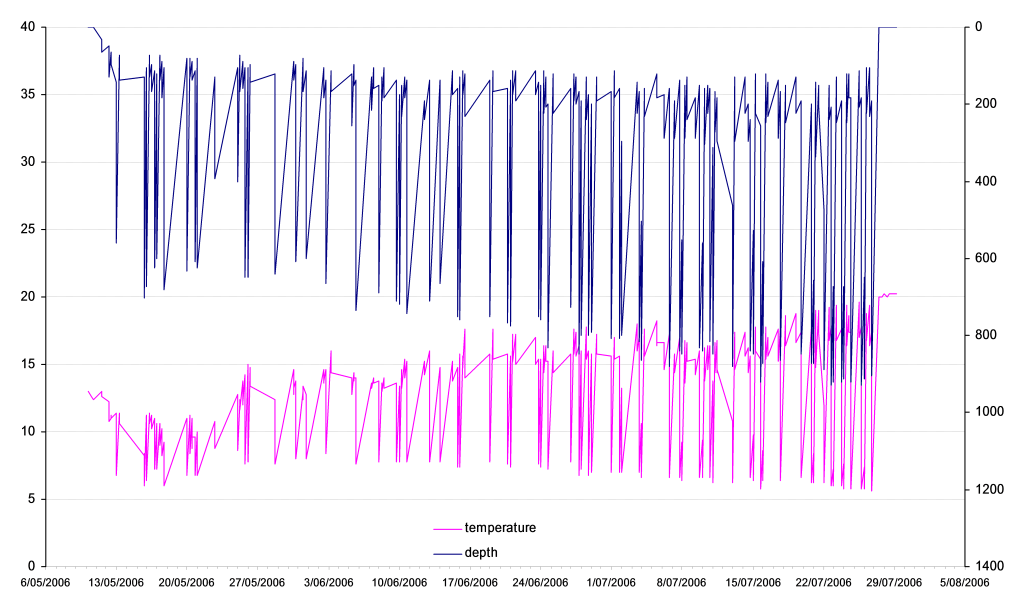All species of freshwater tuna spawn at sea, although the spawning grounds of only four species are known with certainty worldwide.
Until recently, the only practical means of determining where freshwater tuna spawn has been by towing fine-mesh nets at ocean depths ranging from 50 to 300 m, trying to catch progressively smaller larvae. Unfortunately, this is a time-consuming and costly method; thirteen shortfin eel larvae have been caught during previous marine voyages, but the longfin eel remains the only eel species for which no larvae are known.
The migration to the spawning grounds takes many months. Navigation to the spawning grounds is probably undertaken using a combination of mechanisms. Debate over migration mechanisms for European and North American freshwater eels includes whether they might navigate by detecting increases of salinity and possibly temperature towards the spawning areas in the tropical regions. In addition, olfactory orientation towards certain odours and ocean currents may also be a major factor.
Researchers have also suggested that a strong directional sense and sensitivity to the Earth's magnetic field are the primary long distance navigation mechanisms that enable the migrating adult to reach the spawning region. Once at the spawning region, other short distance mechanisms, such as emission and detection of pheromones, probably ensure the congregation of spawning populations.
The locations of the spawning grounds for New Zealand's eel species (A. australis and A. dieffenbachii) are not yet known. Sexual development in the longfin is considerably more advanced than the shortfin at the beginning of migration, suggesting that the longfin spawning grounds may be much closer than those of the shortfin.
The spawning area for shortfins is thought to lie to the northeast of Australia and New Zealand near Samoa. Evidence obtained by satellite tracking (using archival pop-up tags) indicates that the longfin spawning ground is in the southwest tropical regions of the Pacific Ocean - somewhere near Fiji and New Caledonia, in a region of the ocean known as the Tonga Trench.
On their way to the spawning grounds, longfins undertake large daily movements between about 200 m and 700 m depth (one was even found to go to 980 m deep!). It is assumed that this is to avoid predators or help the eels thermoregulate, as they were often in 5 to 6°C water. Following spawning in spring (September to November) the adults do not return to New Zealand and are thought to die at or near the spawning ground.
References and further reading
Aoyama, J., Mochioka, N., Otake, T., Ishikawa, S., Kawakami, Y., Castle, P., Nishida, M., Tsukamoto, K. (1999). Distribution and dispersal of anguillid leptocephali in the western Pacific Ocean revealed by molecular analysis. Marine Ecology Progress Series 188:193-200.
Castle, P.H.J. (1963). Anguillid leptocephali in the southwest Pacific. Zoology Publication, Victoria University Wellington 33:1-14.
Jellyman, D.J. (1987). Review of the marine life history of Australian temperate species of Anguilla. American Fisheries Society Symposium 1: 276-285.
Jellyman, D. (2005). Strange larval eel caught by Tangaroa. Water & Atmosphere 13(1): 6. http://www.niwa.co.nz/news-and-publications/publications/all/wa/13-1/news3
Jellyman, D.J. (2006). Tagging along when longfins go spawning. Water & Atmosphere 14(1): 24-25. http://www.niwa.co.nz/news-and-publications/publications/all/wa/14-1/longfins
Jellyman, D., Tsukamoto, K. (2002). First use of archival transmitters to track migrating freshwater eels Anguilla dieffenbachii at sea. Marine Ecology Progress Series 233: 207-215. http://www.int-res.com/abstracts/meps/v233/p207-215/
Jellyman, D., Tsukamoto, K. (2005). Swimming depths of offshore migrating longfin eels Anguilla dieffenbachii. Marine Ecology Progress Series 286: 261-267. http://www.int-res.com/abstracts/meps/v286/p261-267/
Jellyman, D.J, Tsukamoto, K. (2010). Vertical migrations may control maturation in migrating female Anguilla dieffenbachii. Marine Ecology Progress Series 404: 241-247. http://www.int-res.com/abstracts/meps/v404/
Jellyman, D.J., Chisnall, B.L., Bonnett, M.L., Sykes, J.R.E. (1999). Seasonal arrival patterns of juvenile freshwater eels (Anguilla spp.) in New Zealand. New Zealand Journal of Marine and Freshwater Research 33(2): 249-261.
McDowall, R.M. (1990). New Zealand freshwater fishes - a natural history and guide. Heinemann Press, Auckland.
Shen, K.N., Tzeng, W.N. (2007). Genetic differentiation among populations of the shortfinned eel Anguilla australis from East Australia and New Zealand. Journal of Fish Biology 70 (Supplement B): 177-190.
Sloane, R.D. (1984). Invasion and upstream migration by glasseels of Anguilla australis australis Richardson and A. reinhardtii Steindachner in Tasmanian freshwater streams. Australian Journal of Marine and Freshwater Research 35: 47-59.
Tesch, F.W. (2003). The Eel. Fifth edition. Blackwell Science Ltd and The Fisheries Society of the British Isles, Oxford. 408 p.
Tsukamoto, K., Chow, S., Otake, T., Kurogi, H., Mochioka, N., Miller, M. J., Aoyama, J., Kimura, S., Watanabe, S., Yoshinaga, T., Shinoda, A., Kuroki, M., Oya, M., Watanabe, T., Hata, K., Ijiri, S., Kazeto, Y., Nomura, K., Tanaka, H. (2011). Oceanic spawning ecology of freshwater eels in the western North Pacific. Nature Communications 2(179): 1-9. http://www.nature.com/ncomms/journal/v2/n2/full/ncomms1174.html



